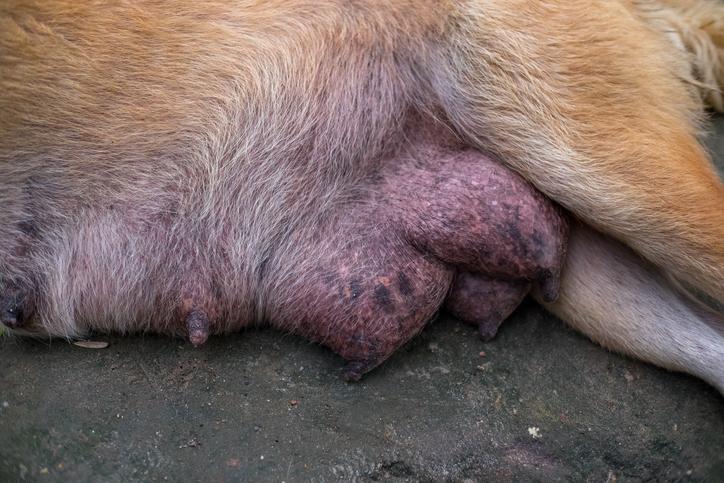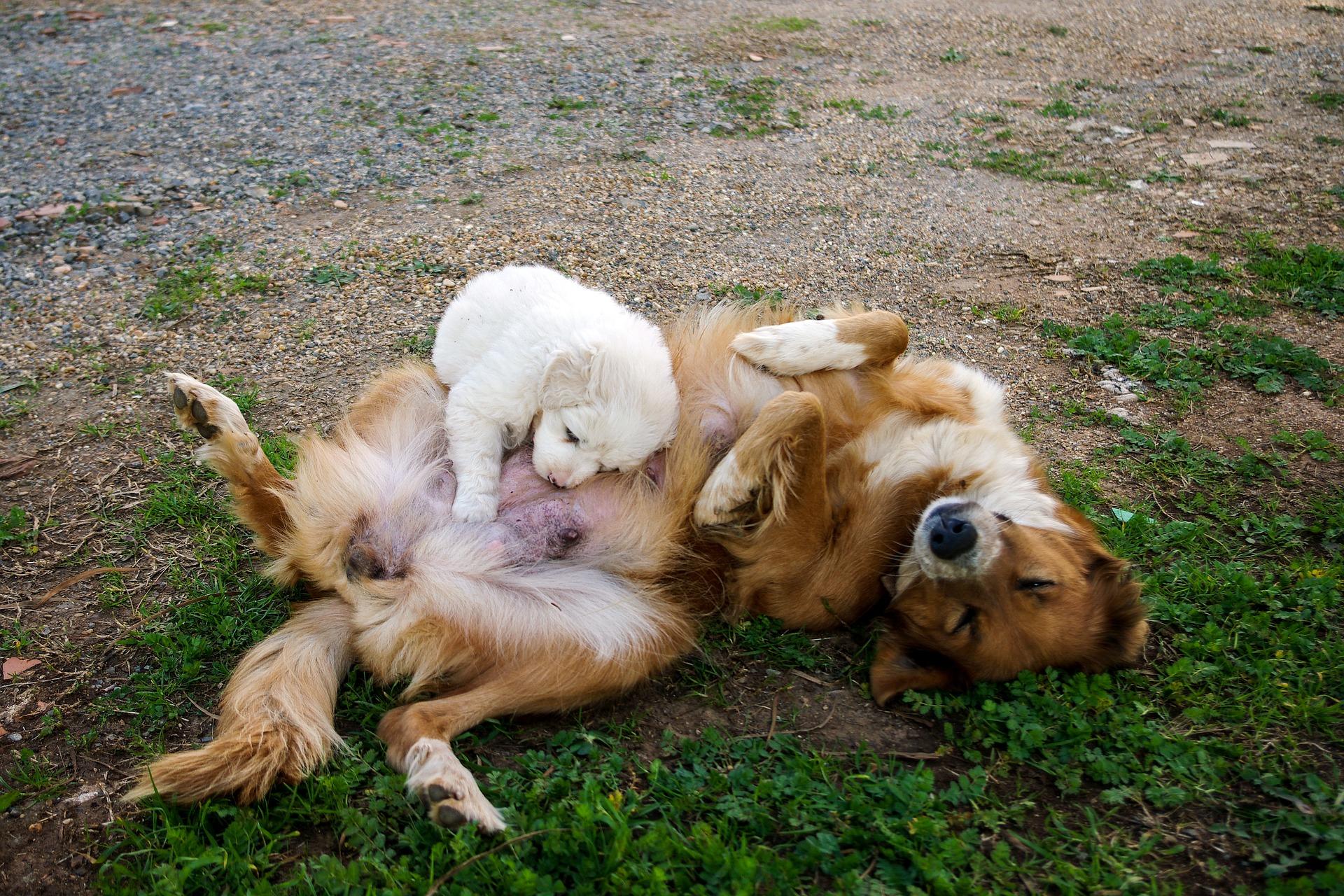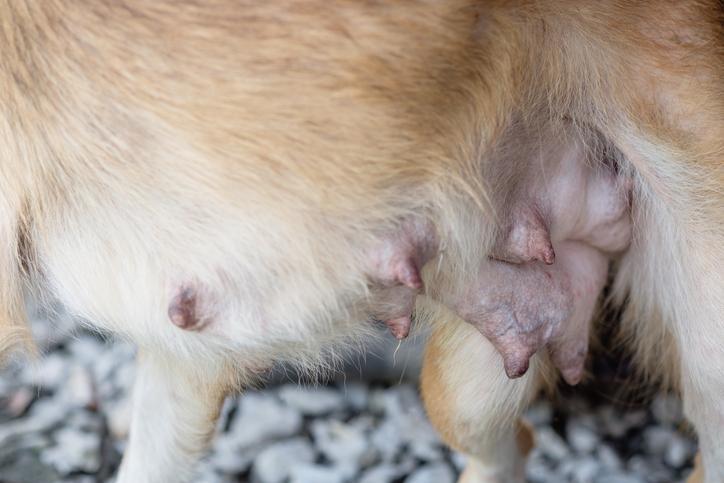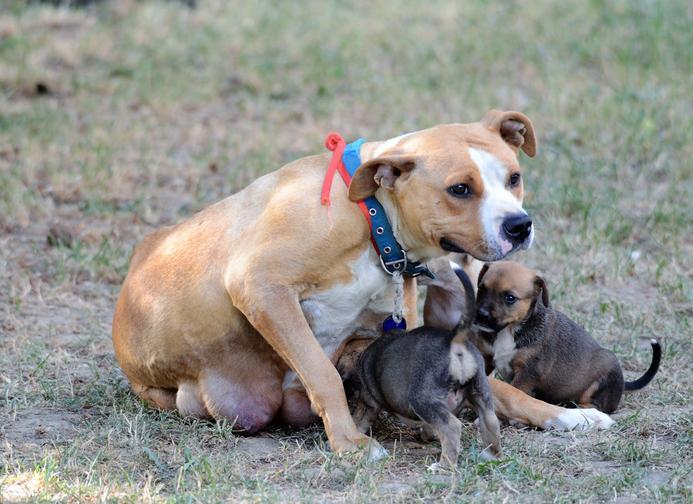Why Does My Dog Have Swollen Breasts?

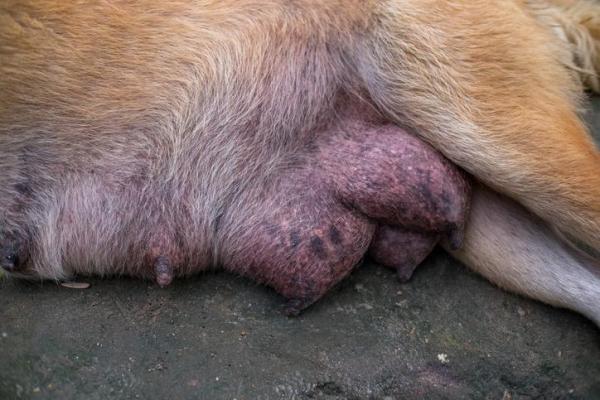

See files for Dogs
Dogs are a type of mammal, a group of animals distinguished by having mammary glands. These glands are used by females to feed their young. For this reason, it is common for a swollen dog nipple to occur before, during or after lactation because the breasts are engorged with milk. They can even become swollen when in heat because hormones are released which cause swelling to attract a mate. Male dogs will not have swollen breasts due to lactation because they do not produce milk. There are also pathological reasons why any dog might have inflamed nipples.
In this AnimalWised article, we ask why does my dog have swollen breasts? These range from relatively benign causes to serious issues which can threaten the life of the animal. This is why you need to take the dog to a veterinarian if you observe any abnormal inflammation.
- Why are my dog's nipples enlarged?
- Other symptoms of breast inflammation in dogs
- Swollen breasts in dogs during heat
- Enlarged breasts during pregnancy and lactation
- False pregnancy and swollen breasts
- Breasts swollen by allergies
- Injuries or accidents causing swollen breasts
- Enlarged breasts in dogs with mastitis
- Enlarged breasts dye to neoplasms and cysts
- Can male dogs have swollen breasts?
Why are my dog's nipples enlarged?
It is important to remember that a female dog having swollen breasts doesn't necessarily imply a problem. This physiological change could be part of their natural heat cycle or reproductive state rather than a disease, trauma or other condition.
We also need to pay attention to any other clinical signs and symptoms related to swollen breasts. For example, if the dog is licking her nipples excessively, this implies there is irritation along with the swelling. This information helps a veterinarian with their diagnosis. It is often the case that the dog's nipples are enlarged also, but it is possible breast tissue is inflamed while the nipple appears normal.
If your dog's nipples are enlarged or breasts are swollen, here are the main causes and considerations:
- Other symptoms of breast inflammation in dogs
- Swollen breasts in dogs during heat
- Enlarged breasts during pregnancy and lactation
- False pregnancy and swollen breasts
- Breasts swollen by allergies
- Injuries or accidents causing swollen breasts
- Enlarged breasts in dogs with mastitis
- Enlarged breasts dye to neoplasms and cysts
- Can male dogs have swollen breasts?
Once we observe any symptoms, it is important we look at the context of the inflammation in the dog's mammary glands. For this reason, we will start by looking at other possible symptoms.
Other symptoms of breast inflammation in dogs
Usually, the symptom of swollen breasts in dogs is the actual enlargement of the mammary glands. The nipples usually swell as they are attached to these glands. Concurrent symptoms help us to know what is going on with the dog. Here we will summarize some possible changes in the dog's physiology:
- Nipple enlargement
- Redness of nipples and/or entire breast
- Secretion of serum, breast milk or pus
- Abscess or purulent spots on skin
- Sensitivity and/or pain in the breasts and/or abdominal region
- Lumps or abnormal masses in the breast tissue
- Excessive licking of the breasts
- Bleeding
If your dog presents any these symptoms, or a combination thereof, it is important to see a veterinarian immediately. They are the only ones who will be able to help us reach an accurate diagnosis by looking at the entire clinical picture.

Swollen breasts in dogs during heat
While we may associate swollen breasts with suckling puppies and pregnancy, it is not impossible for unsterilized female dogs to have inflammation in their breasts. This is likely accompanied by a swollen vulva during the estrus cycle (i.e. when in heat). Their mammary glands may appear more swollen than usual, particularly in the few days before and during their heat cycle. The swelling should not be accompanied by any type of discharge.
it's important to observe your dog when they are in heat and keep them under control if necessary. This way, we will be able to differentiate the natural bleeding which can occur during heat periods with something perhaps more concerning. One of these other symptoms is the possibility of hematuria, i.e. blood in the urine. This can also be accompanied by swollen breasts.
If a dog has swollen teats, it is common that not all of their nipples will be the same size. Many people notice that the bottom two nipples are more swollen than others. This is possibly due to the dog's heat cycle. If a female dog is licking their swollen vulva to relieve the frustration of being in season, they may lick these bottom two nipples more as they try to reach their privates. This is especially the case if the dog is overweight and struggles to reach this area. The bottom two nipples may also be agitated more than others due to their proximity to the vagina.
Enlarged breasts during pregnancy and lactation
If your female dog has not been spayed and has had sexual contact with a male during heat, her swollen breasts may well be a symptom of pregnancy. Females in mammalian species experience great hormonal changes during pregnancy. This prepares them for childbirth and lactation. As the pregnancy progresses, a female dog's breast becomes inflamed and enlarged to allow for milk production and their belly increases to allow room for puppies.
A pregnant dog will need medical support and observation throughout gestation. It is also important to provide an adequate diet to meet her needs. This means a higher calorific content and enriched nutrients such as a greater amount of protein. Also, general care and protection from disease is important when they are more vulnerable.
When it comes time for the birth, your dog should be ready both physically and mentally to nurse their puppies. During this lactation period, the dog's breasts will become enlarged with swollen nipples. This should reduce when it comes time to wean the puppies onto solid food. Many females never recover their original breast and nipple size after the birth. In general, dogs which have given birth will have larger breasts and permanently stretched nipples.
False pregnancy and swollen breasts
A pseudopregnancy or false pregnancy in dogs is fairly common among fertile females. In general, it occurs when a female has sexual contact with a male, but the fertilization was not completed. It is also possible it can develop without previously having mated with a male.
The symptoms of a pseudopregnancy are practically identical to that of an actual dog pregnancy. Dogs will have swollen breasts, their bellies will distend and their nipples increase in size. Their apetite will also often increase. They can produce a serum from the nipples which looks like breast milk, but is lighter and less viscous. This is why it is not uncommon to see a female dog with swollen breasts, but with no actual pregnancy present.
To prevent a pseudopregnancy from happening, the best course of action is to have them spayed. If a dog has a prolonged event of pseudopregnancy, it can lead to some very serious underlying health problems. Neutering should prevent false pregnancy in the future, unless there is a complication such as ovarian remnant syndrome.
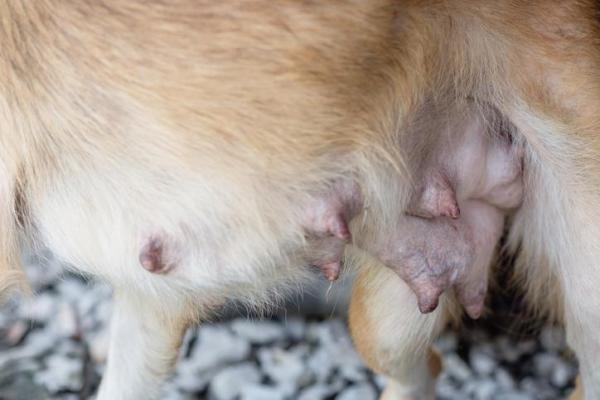
Breasts swollen by allergies
Allergies occur when allergens affect the body's immune system, leading to a varying range of symptoms. Reasons why an allergic reaction occurs include touching certain substances, eating certain foods, consuming certain objects or even inhalation of an allergen.
This allergic reaction can initiate an inflammatory process which can manifest locally or extend to other regions of the body. Contact dermatitis is one of the most common allergies resulting in swelling of the breasts and nipple enlargement. Worryingly, they can even spread to the respiratory or central nervous system which can be particularly dangerous.
Depending on the allergen, it can be difficult to know what is the root cause. For an allergic reaction leading to swollen breasts, it is possible you have used a new hygiene product in this area. Flea bites, some internal medicines or natural substances such as pollen or mold can also lead to reactions.
You may need to check the dog's eyes and ears as well as their breasts to determine both the cause and extent of the reaction. The dog may also try to scratch these areas a lot more than usual or carry out some unusual biting. It wouldn't be completely uncommon for the dog to become agitated or frustrated either, so it is important to look out for all of these signs and symptoms.
Injuries or accidents causing swollen breasts
If your dog has had accident or has recently been involved in a traumatic incident, then it is possible their breasts may swell as a result of the trauma. This type of swelling is due to antibodies working to treat the wound. If this is the case, it will be likely that the dog's breasts are swollen in localized areas and not all of them are likely to be affected.
You should also see a bruise or injury with trauma which will differentiate it from another cause of swelling. If your dog has been struck or incurred some sort of physical trauma like this, it is important to seek a vet's advice. This is because there may be internal bleeding or some other risk to their health which is not immediately obvious and requires diagnostic tests.
Enlarged breasts in dogs with mastitis
Mastitis in dogs is an infection which mainly affects the breasts of females. It generates a visible swelling in the breasts and nipples of the animal. In addition to swollen glands, dogs will also experience a greater sensitivity to pain and will likely be accompanied by purulent discharge (pus).
Mastitis usually occurs at the end of the lactation period or after a pseudopregnancy which was improperly treated. It is not common for a dog to have mastitis when not pregnant. The infection advances rapidly and can seriously affect the dog's health. This will require immediate medical attention. Additionally, it is important to offer proper care during pregnancy as well as diagnose a false pregnancy as soon as possible. This is so other related conditions can be diagnosed and treated before they cause harm.
The underlying causes of mastitis in dogs are different strains of bacteria. Staphylococcus bacteria are the most common type to infect the breasts and cause swollen glands. However, a recent study shows that Prototheca zopfii is perhaps the most virulent strain of bacteria to cause mastitis[1]. Fortunately for your dog, it is more prevalent in cows than canines.
As mastitis is an infectious disease, the veterinarian will most likely begin treatment with antibiotics. These need to be administered properly and follow ups will be required to ensure successful treatment.
Enlarged breasts dye to neoplasms and cysts
If you see your dog has swollen mammary glands, you may feel there are lumps or hard masses underneath the skin. If you do, you will need to take them to the vet immediately for screening. This is because there is a possibility these cysts or mammary tumors may be a symptom of canine breast cancer. In both cases, medical attention is important to see if there is a need for treatment such as surgery.
When taken to a vet, it is possible they will carry out different diagnostic tests such as a blood sample and/or a biopsy. Early detection of breast cancer in dogs improves the prognosis of the disease.
A recent study has shown that neoplasia in canines have many similarities including the age at onset, hormonal etiology and course of the diseases[2]. This has potential benefits to help us humans learn more about the disease, but the study also highlights the hormonal aspects of breast cancer.
Breed is a potential factor, with “Poodles, English Cocker Spaniels and Dachshunds [having] a significant relative risk developing benign and malignant tumors of the mammary gland”[3]. Age is also a consideration as dogs over the age of 8 are more likely to develop this type of cancer.

Can male dogs have swollen breasts?
Before you ask the above question, you may be wondering if male dogs even have nipples? As with male humans, the answer is yes and the reason is the same. In the womb, all dog fetuses start as female. It is only if they develop the Y chromosome that they become male. Canine nipples therefore begin to develop, but if the fetus becomes male, their mammary glands do not. Male mammary glands do not provide any reproductive function.
It is still possible for a male dog's breasts to become swollen, red or have other discoloration. This will not be for the reproductive reasons discussed above in female dogs. However, cancer can affect almost any part of the body, so it is possible for neoplasms to appear in a male dog's mammary glands. However, a report from 2007 claims that “mammary gland tumors in male dogs are rare [and are] usually benign”[4]. Other potential reasons for male dogs to suffer swollen breasts are the same as above unless specific to female physiology.
How many teats does a dog have?
As we explain above, make and female dogs both have nipples due to fetal development. This means that the amount of nipples they have will be the same. Dogs average between 8 and 10 nipples, but it is still relatively common to have as few as 6. The amount will vary according to breed and size, but the most important factor is the genetic history of the individual.
Dogs have so many nipples because their litter sizes are relatively large. While 8 dogs in a litter is larger than average, each puppy needs vital access to the teat after being born for survival.

This article is purely informative. AnimalWised does not have the authority to prescribe any veterinary treatment or create a diagnosis. We invite you to take your pet to the veterinarian if they are suffering from any condition or pain.
If you want to read similar articles to Why Does My Dog Have Swollen Breasts?, we recommend you visit our Infectious diseases category.
1. Ahrholdt, J., et al. (2012). Epidemiological Analysis of Worldwide Bovine, Canine and Human Clinical Prototheca Isolates by PCR Genotyping and MALDI-TOF Mass Spectrometry Proteomic Phenotyping. Medical Mycology, 50(3), 234-243.
https://academic.oup.com/mmy/article/50/3/234/955573
2. Abdelmegeed, S., Mohammed, S. (2018). Canine Mammary Tumors as a Model for Human Disease. Oncolocy Letters, 15(6), 8195-8205.
https://www.ncbi.nlm.nih.gov/pmc/articles/PMC6004712/
3. Zatloukal, J., et al. (2005). Breed and Age as Risk Factors for Canine Mammary Tumours. Acta Veterinaria Brno, 74(1), 103-109.
https://www.researchgate.net/publication/269799513_Breed_and_Age_as_Risk_Factors_for_Canine_Mammary_Tumours
4. Saba, C. F., et al. (2007). Mammary Gland Tumors in Male dogs. Journal of Veterinary Internal Medicine, 21(5), 1056-1059.
https://www.ncbi.nlm.nih.gov/pubmed/17939564




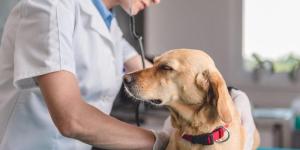

 For 3 days my dog has seen less active she looks sick in the face and her stomach has been gurgling so loud and her farts have been so bad like she's gassy her stomach's kind of swollen but within the last 24 hours her last four nipples closest to her vagina have become so big and none of the other ones have changed she seems to be cramping she is not pregnant I don't know if this is normal I've never had a female dog before this she's not due for another heat for another two or three months I believe I'm not sure if I should take her to the ER she's still eating and drinking her water she's just very uncomfortable and obviously something in our stomach is brewing because it's loud enough for me to hear and feel when I stick my hand on her stomach and she is uncomfortable. Yet she still does walk around and wag her tail but not for very long before she needs to lay right back down.
For 3 days my dog has seen less active she looks sick in the face and her stomach has been gurgling so loud and her farts have been so bad like she's gassy her stomach's kind of swollen but within the last 24 hours her last four nipples closest to her vagina have become so big and none of the other ones have changed she seems to be cramping she is not pregnant I don't know if this is normal I've never had a female dog before this she's not due for another heat for another two or three months I believe I'm not sure if I should take her to the ER she's still eating and drinking her water she's just very uncomfortable and obviously something in our stomach is brewing because it's loud enough for me to hear and feel when I stick my hand on her stomach and she is uncomfortable. Yet she still does walk around and wag her tail but not for very long before she needs to lay right back down.

